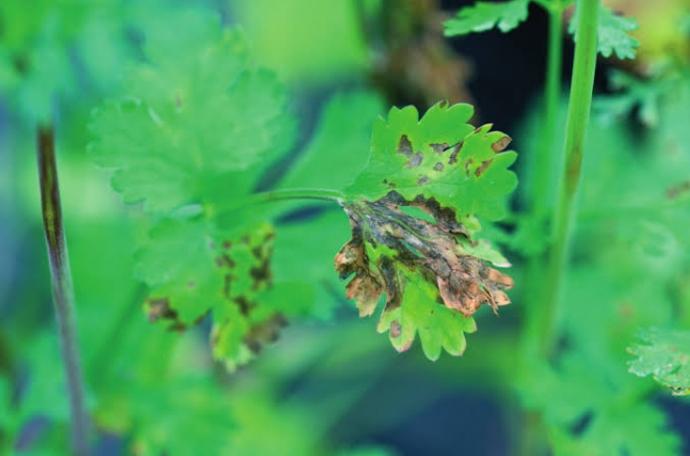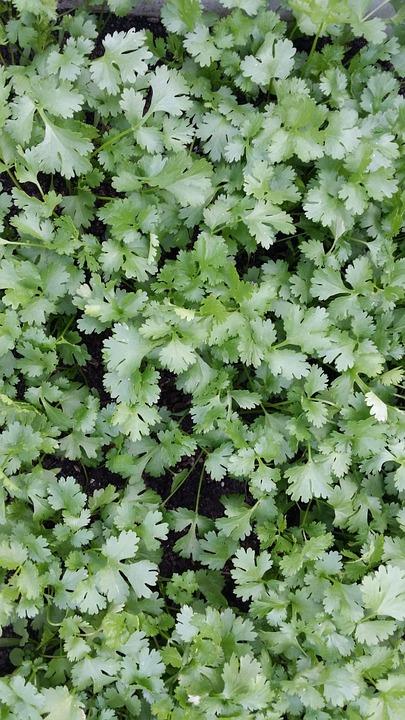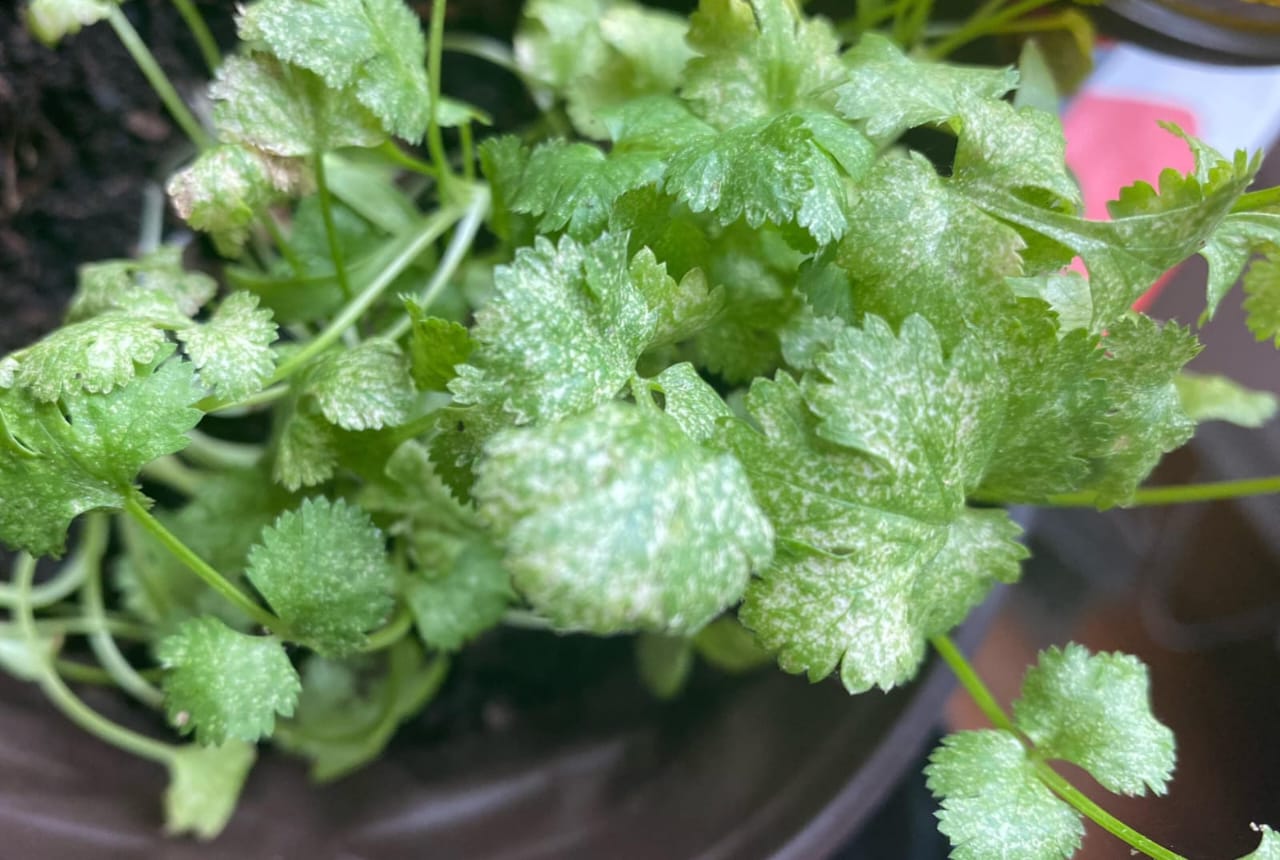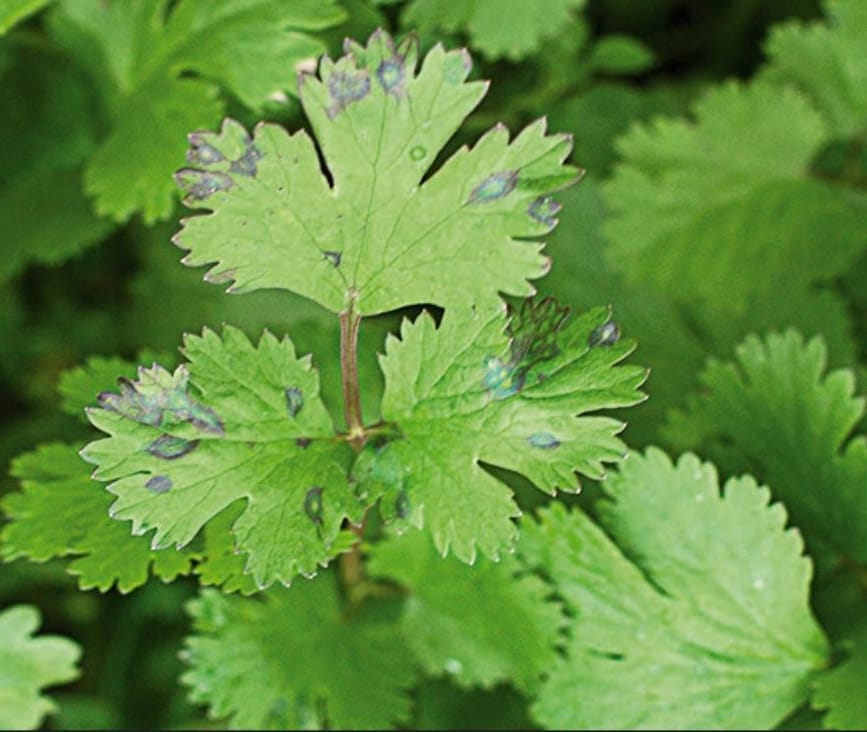Cilantro Plant
Cilantro is an annual, 12-24 inches tall , and frost -tolerant. It prefers well-drained, loamy soil in partial shade to full sun. Keep the soil moist .Cilantro is both edible and has medicinal properties.
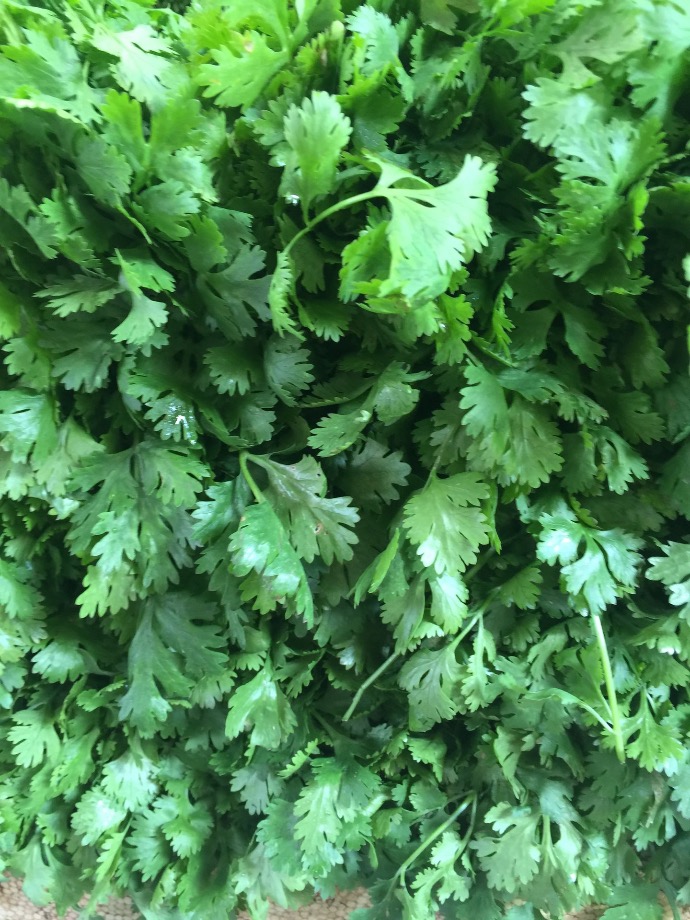
Habit
Annual
Height
30-60 cm
Growth
Fast
Soil
Well-drained, sandy loam
Shade
Partial shade to full Sun
Moisture
Moist
Edible
Yes
Medicinal
Yes
Origin
Mediterranean
Climatic Condition
Temperate
Temperature (°)
10-25°C
Humidity (%)
50-70%
Potting media
Peat, compost
Fertilizers
Organic compost, NPK
Watering
Moderate watering
Plant Weight
50-300 g
Flowering Time
Spring, Summer
Soil Ph level
6.0 - 7.5
Water Ph level
6.0 - 7.5
Soil EC
1-2 dS/m
Yield Per Plant
500 g - 1 kg per plant
NPK ratio
10:10:10
life Span
Annual
Health Benefits
Rich in vitamins A, C, digestion aid
Suggested Grow Media or Potting Mix ?
40% compost, 30% peat moss, 30% perlite
Suggested Fertigation/Fertilizers
Fertilize every 2 weeks with a balanced, water-soluble fertilizer.
Common Diseases and Remedies
Bacterial blight , Powdery Mildew
Leaves spots caused by bacterium , appears as white patches on young stems , leaves , buds .
Spray Neem oil , spray effected leaves with compost tea .
HEALTH BENEFITS
· Rich in antioxidants that help reduce inflammation.
· Supports digestion and may help detoxify heavy metals from the body.
· May lower blood sugar and support heart health.
What Is An Coriander Tree?
Coriander, scientifically known as Coriandrum sativum, is a versatile herb that is widely used in traditional cuisines around the world. Coriander, also known as coriander leaves or Chinese parsley, is an annual herb belonging to the Apiaceae family. It is characterized by delicate lacy leaves and a unique fresh scent. Coriander leaves have a bright lemony flavor that is slightly earthy, and the seeds, known as coriander seeds, impart a warming, slightly lemony spice. Coriander is a staple in a variety of cuisines, especially Latin American, Asian, Middle Eastern, and Indian cuisines, where it is used as a flavor enhancer and garnish. Add a refreshing touch to salsas, curries, salads and soups.
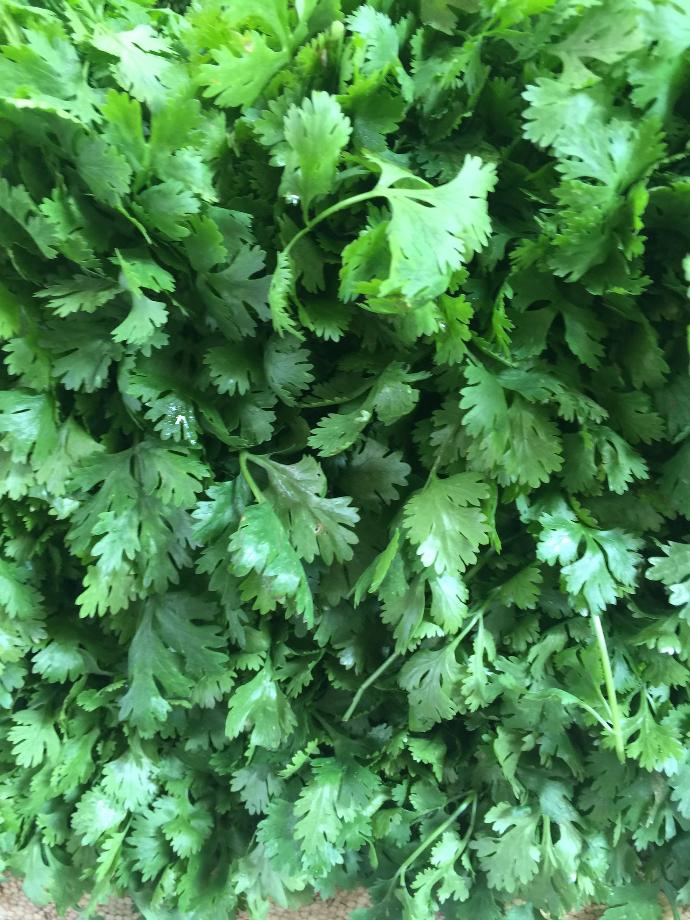
What Are The Different Types Of Cilantro Plants?
1. Santo
This type of coriander is known for being difficult to stand. This means that they produce leaves for a long period of time before flowering. It has a strong and pungent aroma and taste.
2. Calypso
Calypso coriander has thicker stems and larger leaves than other varieties, and has a slightly sweeter, milder flavor.
3. Recreational
Recreational coriander is a slow-growing variety, taking about 10 to 14 days longer to mature than other varieties. It has a light and delicate taste
4. Delfino
Also known as "fern leaf" coriander, delfino has finely cut leaves that resemble fern fronds. It has a slightly lemony and spicy taste.
5. Slow Bolt
Slow Bolt coriander is a popular variety to grow in hot climates because it takes a long time to form seeds and can produce leaves for a long time. It has a sweeter and mellow taste compared to other varieties.
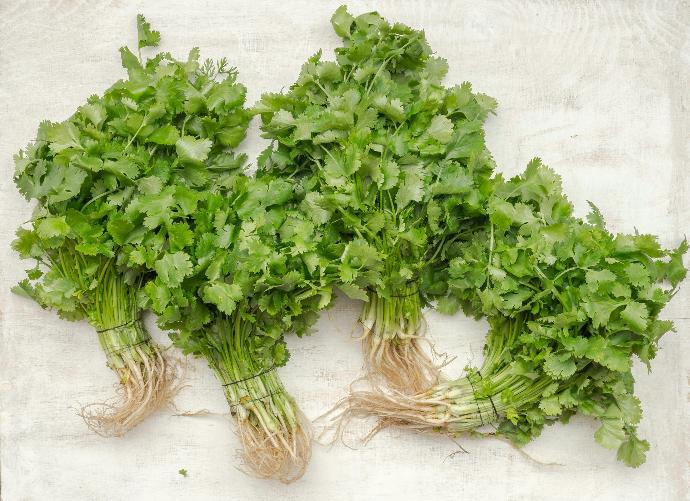
How to care for cilantro Plants ?
1. Location
Coriander (Coriandrum sativum) can be grown indoors or outdoors, giving it flexibility to suit different tastes and climates. Considerations for growing indoors and outdoors include
2. Sunshine
Sunlight or sunlight is an essential element for plant growth. Plants use sunlight for photosynthesis. This is the process of producing food that promotes their growth and development. Sunlight is made up of various wavelengths such as visible light, ultraviolet light, and infrared light. Different wavelengths of sunlight can have different effects on plant growth. For example, blue light promotes vegetative growth, while red light is necessary for flowering and fruiting. Sunlight also plays a role in regulating plant hormones and promoting stress tolerance.
3. Soil
The soil must be loose and well-aerated so that water can flow freely through the soil to avoid flooding. A soil with a pH between 6.0 and 7.0 is ideal for coriander, with slightly acidic soils providing the best growing conditions. Adding organic matter such as well-rotted compost or old manure can help improve soil fertility and structure. These organic materials provide nutrients and beneficial microorganisms to the soil, promoting healthy coriander plant growth.
4. Hydration
Coriander, like most plants, requires plenty of water to grow and stay healthy. Proper watering is important for coriander plants to grow strong roots and lush foliage. However, overwatering can cause problems such as root rot.
5. Nutrition
When first sowing coriander seeds, the soil must be moist but not waterlogged. After the plant takes root, you need to water it thoroughly if the top of the soil feels dry. Coriander prefers constantly moist soil. Therefore, consider using a watering schedule to ensure your plants receive enough water without becoming waterlogged. A balanced fertilizer with a slightly higher nitrogen content may be suitable. Look for an NPK ratio like 10-10-10 or 12-12-12. Coriander does not have high requirements for phosphorus and potassium, but a balanced fertilizer containing adequate amounts of these nutrients will promote overall plant health. Generally, a 10-10-10 ratio is sufficient.
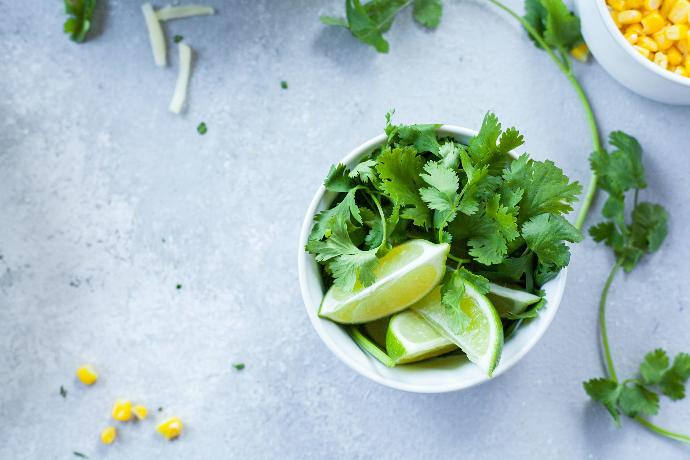
6) Issues
Coriander (Coriandrum sativum) is a generally resilient herb, but certain problems can occur that can affect its growth and health. A common problem is bolting, where the plant quickly forms flowers and seeds, causing a decrease in leaf quality. Screw connections are often caused by high temperatures and prolonged exposure to sunlight. To manage this, plant coriander in a partially shaded area in a warm climate and practice continuous planting to ensure successive harvests. Another problem is fungal diseases such as powdery mildew that can affect the leaves. Ensuring proper air circulation, avoiding overhead watering, and treating with fungicides when necessary will help prevent and control fungal infections. Aphids and spider mites are pests that can affect coriander. The plants will grow and provide a steady supply of fresh leaves for cooking.
What are the Benefits of Cilantro Plants ?
Coriander (Coriandrum sativum) not only adds fresh flavor to dishes, but also offers many potential health benefits. Rich in antioxidants, coriander fights oxidative stress in the body and reduces the risk of chronic diseases. The leaves contain essential oils such as linalool and borneol, which contribute to anti-inflammatory and antibacterial properties. Coriander is associated with digestive effects and may aid digestion and relieve symptoms such as bloating and indigestion. Additionally, coriander is a good source of vitamins such as vitamin A and vitamin K, and minerals such as potassium and calcium. These nutrients play an important role in supporting overall immune health, bone strength, and cardiovascular function. Some studies suggest that coriander may have chelating properties that help remove heavy metals from the body. Although individuals may react differently to the taste of coriander, its potential health-promoting properties make it a worthy addition to a balanced, varied diet.
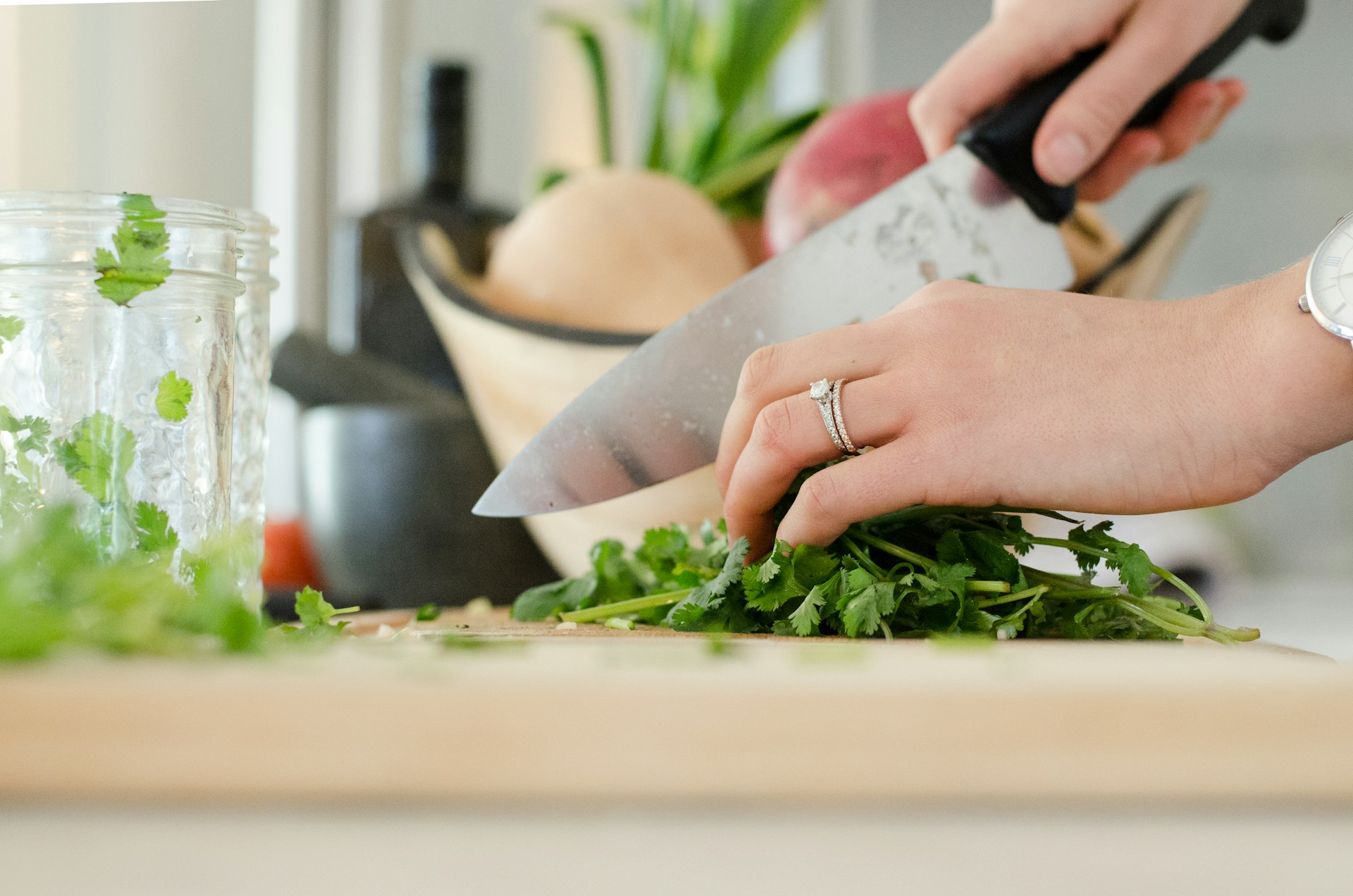
FAQs About Growing Cilantro
1. Can cilantro be grown indoors?
Yes, cilantro can be successfully grown indoors. Ensure it receives at least 6 hours of sunlight per day or supplement with artificial light. Use well-draining soil and containers with drainage holes.
2. Why does cilantro sometimes taste soapy to some people?
Cilantro's soapy taste perception in some individuals is attributed to genetic factors. A specific gene makes cilantro taste unpleasant to some, while others find it refreshing
3. Can you eat cilantro flowers?
Yes, cilantro flowers are edible and can be used as a garnish. They have a similar but milder flavor compared to the leaves.
4. How do you prevent cilantro from bolting?
Bolting (premature flowering) in cilantro can be delayed by planting in partial shade in hot climates, ensuring consistent watering, and practicing succession planting for a continuous harvest.
5. How long does it take for cilantro to grow from seed to harvest?
Cilantro typically takes about 3 to 4 weeks to germinate from seed, and you can start harvesting leaves once the plant reaches about 6 inches in height.
